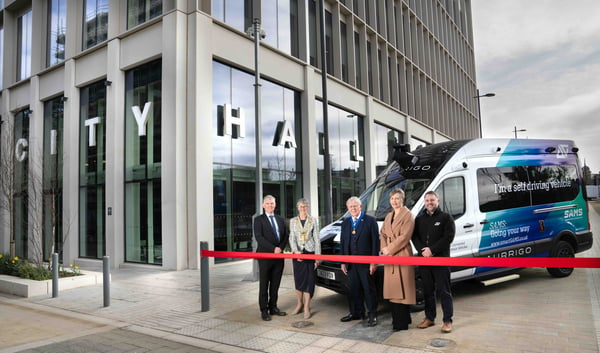Location, Location, Location: Q&A with the DfT
With a budget of £20 billion and with responsibility for the UK's national transport network, it’s no surprise that the Department for Transport is one of the biggest users of location data in government.
As part of our series in geospatial analytics, we turned to officials from the Department of Transport (DfT) to ask how geospatial data is used in the field, the DfT’s contribution to Whitehall interoperability and the long standing question of ensuring data quality.
Q. How is the DfT using geospatial data to make journeys cheaper, cleaner, and quicker?
The Department works with geospatial data on numerous transport projects, conducting analysis to help shape policy and operational decisions, as well as working with the wider transport industry on data and solutions. Recent examples of the Department’s work in this area include analysing how to access electric vehicle charging devices from the Strategic Road Network, identifying freight infrastructure, and producing interactive maps of freight data.
We have a team of geography professionals whose day-to-day work is on geospatial data. They support analysts across the Department to use Geographic Information Systems (GIS) by providing access to a wide range of datasets created internally or sourced from providers such as Ordnance Survey and the Office for National Statistics (ONS). We also maintain strong working relationships with Ordnance Survey and the Geospatial Commission, to improve the quality of national data on transport networks and agree standards for new geospatial data.
Q. How do you ensure the accuracy and reliability of geospatial data, and what standards or protocols are in place for data quality?
We work with the Data and Analysis divisions on quality, accuracy and standards of geospatial data. Internally created geospatial datasets undergo a newly refreshed quality control process to ensure high accuracy and reliability of internal geospatial data provision. Our Geography Network which provides services to the Department in geospatial analysis also advises on geography best practice.
Q. How does your department collaborate with other departments or external organisations on geospatial data projects?
The Department works closely with transport bodies, local authorities and a wide variety of external organisations such as Electric Vehicles work with OZEV. We have also been collaborating with Ordnance Survey and Geoplace to automate collection of the road network data required to allocate highway maintenance funding. As well as a close working relationship, the Department has a strong strategic relationship with Ordnance Survey and the Geospatial Commission. Transport geospatial priorities are established based on detailed discussions between DfT and Ordnance Survey. The Department’s geography professionals are also members of the Government Geography Profession, which supports geographical expertise across the public sector and enables cross-government collaboration.
Q. What systems or platforms are used to facilitate the sharing of geospatial data across different government bodies?
As well as using open-source GIS software, we utilise the Esri suite of GIS solutions to enable the sharing of geospatial data and interactive mapping. We also publish subnational transport statistics wherever available, using geospatial codes and naming conventions from the ONS to enable the public to use and link our data. We also publish open-source geospatial data such as the National Public Transport Access Nodes (NAPTAN), as well as encouraging and facilitating open source data from local authorities and the wider sector.
Q. The Transport Data Strategy (TDS) report highlighted 7 key barriers to widespread innovation in transport data: discoverability, data illiteracy, lack of leadership, legal barriers, lack of data quality and availability and security concerns. How do you believe the Department has managed these challenges since the Strategy was published?
The Department has made good progress on improving data sharing including:
- Bus Open Data - giving customers better information on bus trips.
- Street Manager - giving up-to-date and accurate data on planned and live works.
- Modernising “NaPTAN” a national dataset of bus stops, coach stations, rail stations, airports, ferry piers, and underground stops.
- The Rail Data Marketplace - a new way of sharing data within the industry but also with app developers, tech firms and academia.
We engage with the sector predominantly through the Transport Technology Forum (TTF) and through the TTF data working group, we are looking at how we can better share learnings and improve awareness of existing guidance. The Transport Select Committee (TSC) inquiry into the future of transport has been a useful platform for engagement with the sector and their report will help inform next steps on the TDS. We have also established a wider Departmental family data working group to progress the Strategy.
Q. How has DfT worked to spread data capability across non-data users? What have the results of this been?
We work closely with local authorities and the supply chain through the TTF to encourage adoption of new methodologies, share best practice and deliver a more cohesive approach. The TDS also includes an action to develop and coordinate a programme of transport innovation events in collaboration with a range of stakeholders and we have attended various events including the TTF and with Google to encourage take up.
Q. How has DfT contributed to increased data interoperability across Whitehall?
DfT is collaborating on multiple projects across Whitehall, sharing good practices and learning from each other, as well as directly collaborating in project delivery. Examples include collaboration between the Department’s Digital Twins team and the National Digital Twin Programme (NDTP), led by the Department of Business and Trade which combines expertise in transport-specific data, models and analytical assumptions, with the NDTP demonstrator at the Isle Wight. This project is delivering a single platform to combine diverse data sources (including energy, transport, healthcare and housing) and provide tools for different levels of government to prepare, coordinate and respond to events such as flooding and coastal erosion.




.jpg?width=600&name=GovX%20Show%20title%20NEW%20(13).jpg)

